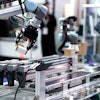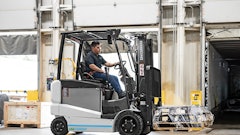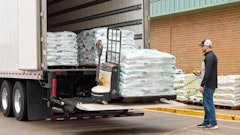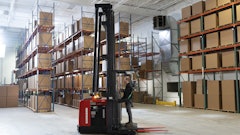
Adding automation technology to improve warehouse operations efficiency is no novel concept. Automatic Storage and Retrieval Systems (AS/RS) have been on the scene since the late 1970s, but traditionally these systems were designed as part of a new facility. Today’s food distribution companies are just as interested in the technology, but due to the high cost of land and construction, the trend is now retrofitting existing facilities with AS/RS.
Ken Ruehrdanz, distribution and warehousing market manager of Dematic, located in Grand Rapids, MI, says more than 50 percent of Dematic’s food distribution customers are adding AS/RS to existing buildings, as opposed to building new facilities.
Retrofitting a facility presents unique challenges to the operation, but the return on investment is significant. Proper design, careful preparation and the right equipment can help make the transition a smooth one.
Retrofitting Challenges
The two most prevalent challenges DCs face during a retrofit are: 1) how to keep materials flowing smoothly while the new infrastructure is being installed, and 2) how to integrate the new AS/RS software with current warehouse control systems (WCS).
Strategies to combat the first obstacle include workarounds, working during off-shifts, clearing paths and maintaining frequent communication between the DC and its customers.
Cory Flemings, executive sales manager, automated systems division, of Schaefer Systems International Inc., Charlotte, NC, notes that these solutions don’t only require logistical planning, but also financial planning.
“During planning, consider all the costs including labor to move your inventory, restocking costs and temporary storage costs,” says Fleming.
The second challenge, IT interface between the enterprise system and the WCS, is another issue that must be addressed during the planning phase.
Today many aspects of the warehouse, including the AS/RS, are controlled by a single WCS. Bruce Boldrin, corporate accounts manager, Daifuku America, Salt Lake City, says the challenge is to integrate the systems so the AS/RS can count inventory, store and retrieve to order, and use the tracking capability to replenish forward picking systems with pallets, totes and cases.
Tom Swovick, system sales manager, food and beverage, for TGW Systems Inc. of Spring Lake, MI, says one other challenge is making sure integral moving parts of the warehouse are compatible with the AS/RS.
“Automation devices require equipment to be repeatable and precise,” says Swovick. “There has to be a lot of care applied to the pallets they’re receiving and handling. They must be square and uniform to help the system work effectively. The AS/RS is more precise than conventional methods, so it needs more precise inputs.”
The solution to all these challenges lay in good and thorough design and preparation on behalf of the entire organization.
Designing Solutions
The design and planning phase of an AS/RS retrofit can take nearly three times longer than the implementation phase. That is because so many factors need to be taken into consideration. Companies like Daifuku America use sophisticated data collection methods to ensure their retrofit design will meet their customers’ needs.
“We have developed analytical and graphical tools to support in-depth analysis of the current data and operations,” says Boldrin. “We learn their business and the business’ drivers. This front work enables formulation of the specific business objectives and solutions based on the cost/value of rebuilding or replacing equipment and warehouse controls; adding functionality and interfacing to expanded operations.”
Planning and designing for operations expansion is equally important in newly built facilities as it is in retrofits.
A plan for continued growth was a main consideration for LiDestri Foods, located in Fairport, NY, when it built its 200,000-square-foot facility in 1998. LiDestri, a manufacturer of sauces, dips, and salsas for many well-known and private label brands, equipped the facility with an ACTIV System from Retrotech Inc., Victor, NY.
Lee Biscardi, director of warehousing and logistics for LiDestri Foods says the design and planning phase lasted eight to nine months before implementation began. “We thought we’d grow 10 percent, but we grew more. We were able to meet our exceeded growth expectations thanks to Retrotech’s five year plan. They don’t just look at your throughput now; they look at projections into the future.”
A major aspect of the planning process will depend on what type of AS/RS is being installed in the facility.
The Right AS/RS
For LiDestri’s new facility, the right solution was Retrotech Inc.’s ACTIV System, a unit load AS/RS which includes Vertical Transfer Lifts (VTLs), Cross-Aisle Transfers (CATs), and Deep Lane Transfers (DLTs) to position the incoming pallets within the system based on output requirements.
The miniload AS/RS is a popular retrofitting option. A mini load AS/RS replaces conventional static rack to maximize vertical storage space within a compact footprint. Instead of using pallets, the miniload moves and stores items in totes, containers or cardboard boxes. Items are transported to and from the mini load by conveyor, shuttle fork, side belt, side clamp, Sorting Transfer Vehicle (STV) or Automatic Guided Vehicle (AGV).
According to Dematic’s Ruehrdanz, miniload AS/RS is more adaptable since it does not require a rack supported building. Unit load AS/RS usually require a rack supported building.
Ruehrdanz explains one of Dematic’s most popular solutions for customers seeking to retrofit.
“Dematic has introduced a flexible and scalable ASRS technology called Multishuttle,” Ruehrdanz says. “This solution is ideal for retrofitting to existing buildings. The technology features shuttle cars that are powered with a low voltage electrical system. The shuttles store and retrieve cases or tote boxes in a rack structure. The solution is inherently more scalable and easier to install in existing operations since there is no ‘stacker crane’ installation required. Throughput capacity ranges from three to four times that of traditional AS/RS.”
Bill Leber, director of business development and marketing of Swisslog in Newport News, VA, says its AutoStore is another ideal option for retrofitting applications.
AutoStore is unique and lightweight because it uses an aluminum grid structure organized in rectangular cells, instead of traditional steel racking structures. Several different configurations are available, allowing AutoStore to surround pillars and other physical building characteristics.
Retrofitting an existing facility with AS/RS requires a capital investment, but can be well worth it.
Return On Investment
LiDestri’s Biscardi says the benefits of automation were immediate for the company.
“Before moving into our new facility, we were utilizing two warehouses to meet our demands,” says Biscardi. “At that time we were doing 80 to 90 loads a day. After utilizing automation, we could run 105 loads in 18 hours with only 12 employees.”
Also, after moving out of its two other facilities, LiDestri eliminated about $500,000 per year on freight costs and was able to significantly reduce damages. They also decreased truck loading time from one-and-a-half hours to 40 minutes.
Utilizing pallets built by AS/RS can even lead to a reduction in fleet size. TGW’s Swovick explains, “Without automation, pallets are not always optimally stacked. Therefore, trucks are not as efficiently loaded and fewer drop offs are made per route. Typically the fleet had to be larger to satisfy their orders, so automation not only serves efficiency in the warehouse, but in the overall supply chain network.”
Today’s leading AS/RS providers are constantly producing new solutions for the industry. Through careful planning, equipment selection and execution, an AS/RS retrofit can be a seamless transition that produces immediate return on investment.



















